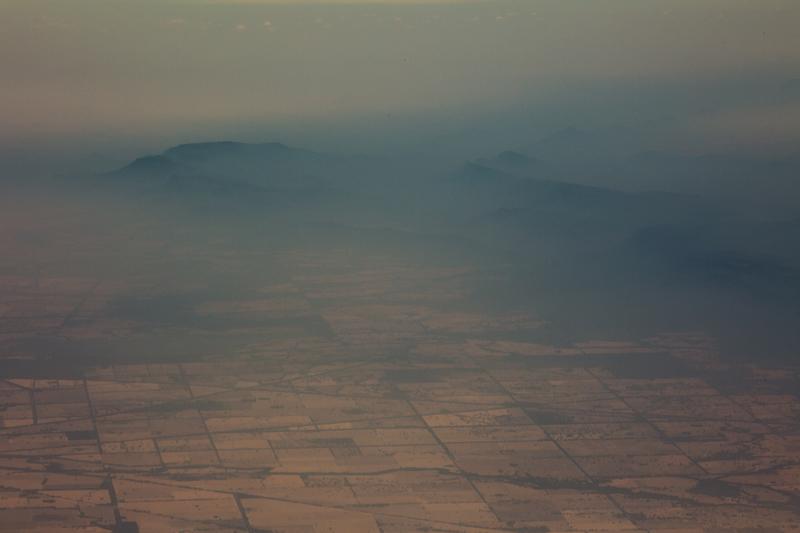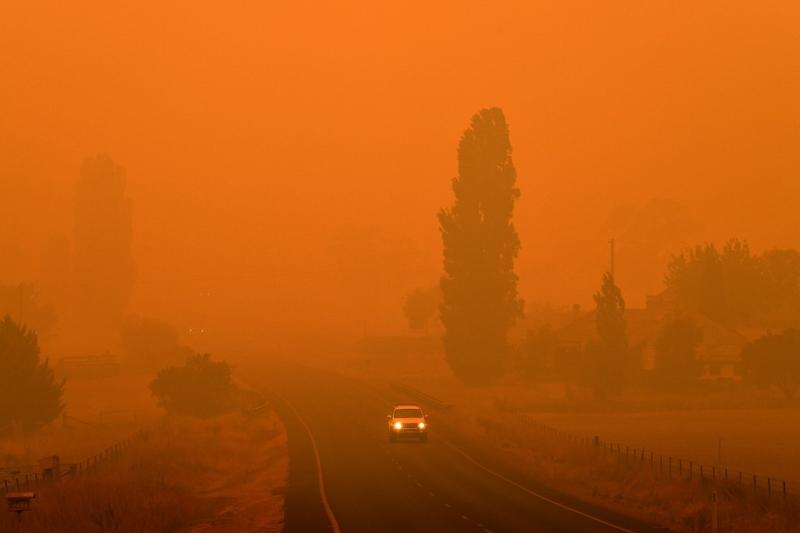 In this image released by the Australian Department of Defence and dated Jan 7, 2019, smoke and haze hangs over mountains near Cooma, New South Wales from a No 11 Squadron P-8A Poseidon conducting damage assessment and surveillance in the bushfire affected area. (AUSTRALIAN DEPT. OF DEFENCE VIA AP)
In this image released by the Australian Department of Defence and dated Jan 7, 2019, smoke and haze hangs over mountains near Cooma, New South Wales from a No 11 Squadron P-8A Poseidon conducting damage assessment and surveillance in the bushfire affected area. (AUSTRALIAN DEPT. OF DEFENCE VIA AP)
SYDNEY — Mining giant BHP Group (BHP.AX) said on Tuesday that poor air quality caused by smoke from Australia’s bushfires is hurting coal production, as authorities said a reprieve from hazardous fire conditions would end within days.
The warning from the world’s biggest miner showed how an unusually long bushfire season that has scorched an area one-third the size of Germany is damaging the world’s No. 14 economy
The warning from the world’s biggest miner showed how an unusually long bushfire season that has scorched an area one-third the size of Germany is damaging the world’s No. 14 economy.
Australia’s tourism and insurance industries have already foreshadowed they face a A$1 billion (US$687 million) hit each from the fires.
Scores of fires were still burning on the east coast on Tuesday despite thunderstorms and rain in recent days.
Officials in New South Wales issued a high fire danger rating on the state’s south coast, while temperatures were forecast to rise in inland parts of Victoria state and neighboring South Australia on Wednesday.
Combined with strong winds, the hotter temperatures will potentially fan existing bushfires and spark new ones into life, leading officials to declare “extreme fire danger” in some areas.
“Tomorrow is real for us, extremely real,” Victorian Emergency Management Commissioner Andrew Crisp told reporters in Melbourne.
 Cars drive down a freeway as smoke shrouds the Australian capital of Canberra, Australia, Jan 1, 2020. (MARK BAKER / AP)
Cars drive down a freeway as smoke shrouds the Australian capital of Canberra, Australia, Jan 1, 2020. (MARK BAKER / AP)
BHP said smoke and dust from bushfires had reduced air quality at its energy coal mines in New South Wales state, and if the deterioration continued “then operations could be constrained further in the second half of the year.”
The company later added in an emailed statement that operations had been affected by machines operating more slowly due to reduced visibility, while some staff had taken leave to protect their property from the fires.
The fierce bushfires in Australia’s east have killed 29 people and millions of animals, destroyed more than 2,500 homes and razed 11 million hectares of wilderness since September. The crisis follows three years of drought that experts have linked to climate change.
The disruption has extended to the capital, Canberra, and its two biggest cities, Sydney and Melbourne, all of which have been repeatedly blanketed in thick smoke that has earned them air quality ratings among the worst in the world.
ALSO READ: Smoke stalls rescues as Australia plans for next fiery onslaught
Here are today’s key events in the bushfire crisis:
** By Tuesday evening, 64 fires were burning across New South Wales, none above the lowest warning level. There were 25 emergency warnings in Victoria.
** The Bureau of Meteorology warned the East Gippsland region to expect strong winds after thunderstorms rolled through a day earlier. Earlier this month, people in East Gippsland were evacuated by Navy ships as bushfires destroyed whole towns.
 Residents commute on a road through thick smoke from bushfires in Bemboka, in Australia's New South Wales state on Jan 5, 2020. (SAEED KHAN / AFP)
Residents commute on a road through thick smoke from bushfires in Bemboka, in Australia's New South Wales state on Jan 5, 2020. (SAEED KHAN / AFP)
** The NSW state government, meanwhile, said it was increasing a grant for primary producers affected by the fires to A$75,000, from A$15,000 previously.
READ MORE: Australia's platypus fights for survival amid prolonged drought
** A survey by Deloitte of 2,000 executives published on Tuesday showed 89% of Australian business executives viewed climate change and environmental sustainability as the “societal issue of greatest focus,” compared to 54% world-wide.
** The Australian Open tennis tournament continued in Melbourne. The city’s air quality was rated as “good”, according to the Air Quality Index, having been “hazardous” less than a week earlier, when a player collapsed in the preliminary rounds.
** The tennis community has raised more than A$50 million for bushfire relief, according to Tennis Australia.


